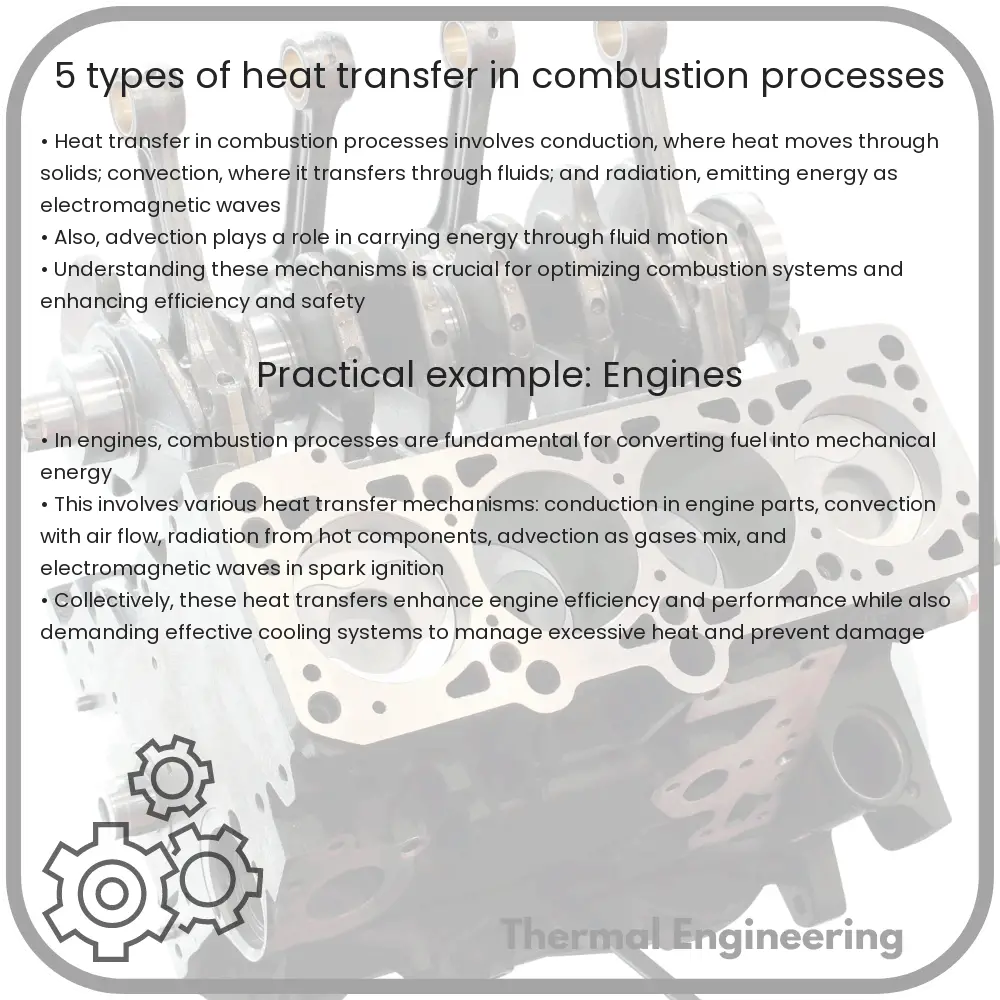Explore the fundamental roles of conduction, convection, radiation, advection, and mass transfer in enhancing heat transfer efficiency in combustion processes.

Understanding Heat Transfer in Combustion Processes
Heat transfer in combustion processes is a fundamental concept in the field of thermodynamics and plays a crucial role in various engineering applications, including power generation, automotive engines, and industrial furnaces. The efficiency of combustion systems heavily relies on the effectiveness of heat transfer mechanisms. There are five primary types of heat transfer in combustion processes: conduction, convection, radiation, advection, and mass transfer. Each type has unique characteristics and effects on how heat energy is distributed and used in combustion systems.
1. Conduction
Conduction is the transfer of heat through a solid material from one molecule to another without any movement of the material as a whole. In combustion chambers, heat conduction occurs in the walls and other solid components. The rate of heat conduction through a material is governed by Fourier’s law of heat conduction, which can be expressed as:
q = -k * A * (dT/dx)
- q is the heat transfer rate.
- k is the thermal conductivity of the material.
- A is the cross-sectional area through which heat is flowing.
- dx is the thickness of the material.
- dT is the temperature difference across the material.
2. Convection
Convection is the transfer of heat by the movement of fluids (liquids or gases). In combustion processes, hot combustion gases transfer heat to cooler areas of the system or to surfaces such as heat exchanger tubes through convective motion. Convection can be natural (driven by buoyancy forces due to temperature differences) or forced (enhanced by external means such as fans or pumps). The convective heat transfer rate can be described by Newton’s law of cooling:
q = h * A * (Tsurface – Tfluid)
- h is the heat transfer coefficient.
- A is the area where convection occurs.
- Tsurface is the temperature of the surface.
- Tfluid is the temperature of the fluid.
3. Radiation
Radiation involves the transfer of heat in the form of electromagnetic waves, primarily infrared radiation, without any medium. This type of heat transfer is significant in high-temperature environments typical of combustion. The Stefan-Boltzmann law quantifies radiant heat transfer:
q = ε * σ * A * (T4)
- ε is the emissivity of the surface (ranging from 0 to 1).
- σ is the Stefan-Boltzmann constant (5.67 x 10-8 W/m2K4).
- T is the absolute temperature of the surface.
4. Advection
Advection is the transport of heat by the bulk movement of a fluid. In combustion, this can occur when hot gases flow through ducts or when the flame itself moves, carrying energy from one location to another. Advection can also involve movements generated by external factors like wind or by the combustion process itself.
5. Mass Transfer
Though not a direct mode of heat transfer, mass transfer significantly influences combustion processes by including the movement of combustible species to the flame and the resulting products away from it. This movement can affect the temperature profiles and combustion efficiency. Mass transfer often collaborates with convection, where the motion of mass (fluid containing heat) contributes to heat distribution in a system.
Understanding these methods of heat transfer allows engineers to design more efficient combustion systems, optimize energy usage, and reduce emissions, ultimately leading to improved performance and lower environmental impacts.